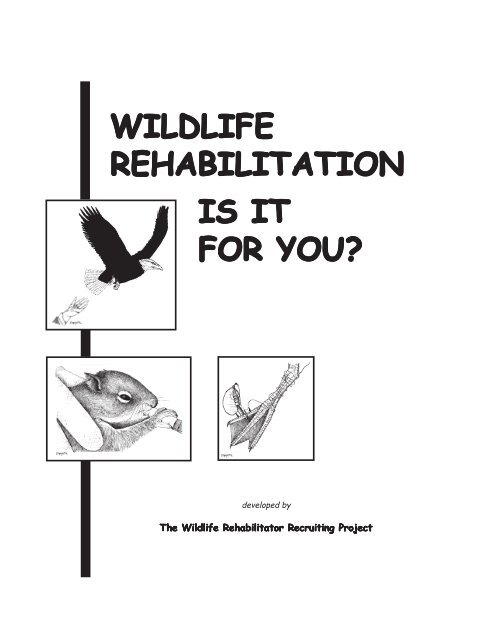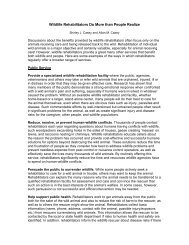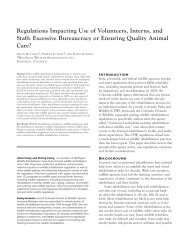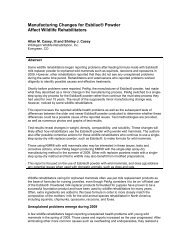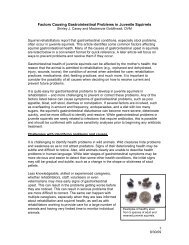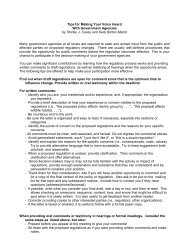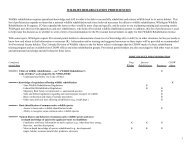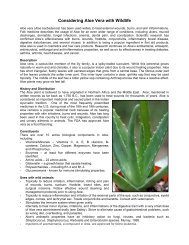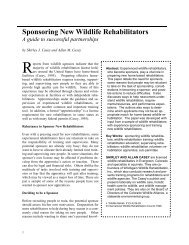WILDLIFE REHABILITATION IS IT FOR YOU? - WildAgain Wildlife ...
WILDLIFE REHABILITATION IS IT FOR YOU? - WildAgain Wildlife ...
WILDLIFE REHABILITATION IS IT FOR YOU? - WildAgain Wildlife ...
You also want an ePaper? Increase the reach of your titles
YUMPU automatically turns print PDFs into web optimized ePapers that Google loves.
<strong>WILDLIFE</strong><br />
<strong>REHABIL<strong>IT</strong>ATION</strong><br />
<strong>IS</strong> <strong>IT</strong><br />
<strong>FOR</strong> <strong>YOU</strong>?<br />
developed by<br />
The <strong>Wildlife</strong> Rehabilitator Recruiting Project<br />
1
Thank you for your interest in wildlife rehabilitation. We are always happy to explain wildlife rehabilitation to people<br />
who are interested in and care about wildlife. Before we tell you what is involved, let us first explain what it is, why it is<br />
needed, and some of the benefits of being a wildlife rehabilitator.<br />
What is <strong>Wildlife</strong> Rehabilitation?<br />
<strong>Wildlife</strong> rehabilitation is the process of providing aid to injured, orphaned, displaced, or distressed wild<br />
animals in such a way that they may survive when released to their native habitats. The spectrum of activities<br />
ranges from direct care of wildlife to arranging suitable release sites. <strong>Wildlife</strong> rehabilitation also involves<br />
anticipating and helping to prevent problems with wildlife as well as humanely resolving human-wildlife<br />
conflicts. <strong>Wildlife</strong> rehabilitation is part science, part education, part problem-solving, and part care-giving.<br />
<strong>Wildlife</strong> rehabilitation is a growing activity with a rapidly expanding base of knowledge and ever-increasing<br />
professional standards. Generally, by law, free-ranging native wildlife is a natural resource that belongs to the<br />
public. <strong>Wildlife</strong> rehabilitation is regulated by state or provincial and federal wildlife agencies.<br />
Why is <strong>Wildlife</strong> Rehabilitation Needed?<br />
Contact between humans and wildlife grows daily as humans expand into or destroy wildlife habitat. In<br />
most cases, when humans and wildlife collide, wildlife suffers. <strong>Wildlife</strong> rehabilitation gives these wild<br />
animals a second chance to live free in their natural habitat.<br />
In an increasingly urbanized world, people are less likely to have personal knowledge of and experience with<br />
nature and wildlife. When they encounter wildlife in their communities, people both want and need information<br />
about how to co-exist with their wild neighbors. Reducing humanwildlife<br />
conflicts can help both wildlife and humans. Rehabilitators<br />
often provide critical education which helps reduce human-wildlife<br />
conflicts and expands the sense of stewardship of the natural world.<br />
Rehabilitators can provide valuable assistance and advice to growing<br />
numbers of people who value wildlife and make personal efforts to help<br />
wild animals in need.<br />
Helping wildlife in need is not an easy task. Working with wildlife<br />
requires specialized knowledge, skill, and facilities. Potential dangers<br />
exist for the public, domestic animals, and wildlife when untrained and<br />
uninformed people attempt to provide care for wildlife. <strong>Wildlife</strong><br />
rehabilitators are trained to provide specialized care that reduces risks to<br />
humans and animals, and increases the chances for the animal’s return<br />
to health and successful release back to the wild. They hold the permits<br />
or licenses to allow them to legally possess wild animals for rehabilitation and release.<br />
Benefits of Being a <strong>Wildlife</strong> Rehabilitator<br />
• Rehabilitation provides a personal connection with nature and wildlife.<br />
• Rehabilitation offers a positive and personal way to give back to nature for all that humans take and the<br />
problems we create.<br />
• Rehabilitation brings a feeling of satisfaction from releasing a healthy, strong, viable wild animal back to<br />
live wild and free in its natural habitat.<br />
• Rehabilitation provides a unique opportunity for learning about wildlife, nature, environmental issues, and<br />
human values.<br />
• Rehabilitation creates an on-going opportunity for personal growth, involving such skills as problemsolving,<br />
priority-setting, decision-making, conflict and crisis management, and building self-confidence .<br />
• Rehabilitation provides an opportunity to talk with people about wildlife and impart an appreciation for<br />
native wildlife and habitat.<br />
• Rehabilitation can help individual wild animals and help us discover ways to help wildlife populations at<br />
risk.<br />
****************<br />
2
Many people are attracted to wildlife rehabilitation because they believe it is a valuable and rewarding activity. However,<br />
there are more facets to wildlife rehabilitation than most people initially expect. It can also be demanding and<br />
difficult. We believe that a better understanding of what is involved can help you make a more informed decision about if,<br />
how, and when you might want to become involved in wildlife rehabilitation.<br />
As we begin to describe wildlife rehabilitation, we will also highlight some of the commonly held myths.<br />
Different Types of <strong>Wildlife</strong> Rehabilitation<br />
The majority of wildlife rehabilitators in North America have independent home-based facilities. Some may<br />
admit a wide range of species, ages, and health conditions. Others may specialize in certain types of animals,<br />
such as swallows, hummingbirds, bats, or squirrels. Some further restrict their rehabilitation to either juvenile<br />
or adult animals. Some may work with all types of injuries or conditions, while others may specialize in<br />
raising orphans with minimal health problems. Some accept wildlife from a wide region, others accept<br />
animals from a limited area. Some have a small facility and work with a few animals each year, while others<br />
have a larger facility and work with several hundred.<br />
Myth 1<br />
Anyone who finds an injured or orphaned<br />
wild animal can take it<br />
home and care for it, and everything<br />
will be wonderful. <strong>Wildlife</strong> requires<br />
specialized care to survive, especially<br />
those that are injured or orphaned. Without<br />
such specialized diets, feeding, cages,<br />
and treatment, these animals may suffer<br />
or die. Working with wildlife carries<br />
risks of injury, disease, and parasites for<br />
humans and domestic animals. Inappropriately<br />
released wildlife can result in<br />
problems for wild populations. Possession<br />
of wildlife requires various permits<br />
and licenses. Working with wildlife is a<br />
serious activity and has special requirements.<br />
Larger wildlife rehabilitation centers may also take in a wide range<br />
of species or specialize. For example, some rehabilitation centers<br />
admit everything from turtles, pigeons, songbirds, and waterfowl,<br />
to rabbits, raccoons, and coyotes. Others specialize in raptors, deer,<br />
reptiles, or marine mammals. <strong>Wildlife</strong> centers often admit and<br />
rehabilitate larger numbers of animals, ranging from hundreds to<br />
thousands.<br />
Descriptions of <strong>Wildlife</strong> Rehabilitation Facilities<br />
<strong>Wildlife</strong> rehabilitation may be conducted in the homes of permitted<br />
or licensed wildlife rehabilitators; in dedicated, stand-alone<br />
rehabilitation facilities or centers; or as a separate affiliate of<br />
another organization such as a humane society, animal sanctuary,<br />
or veterinary clinic.<br />
Regardless of where the rehabilitation is conducted, it needs to<br />
meet established criteria; standards for safety, cleanliness, and<br />
sanitation; and government agency regulations (including rehabilitation,<br />
health, and zoning regulations and ordinances).<br />
<strong>Wildlife</strong> rehabilitation requires facilities for wildlife that are<br />
separate from humans and domestic or exotic animals in order to<br />
reduce stress and the transmission of disease and parasites, and to avoid improper imprinting on other<br />
species. This includes both indoor and outdoor caging. If wildlife rehabilitation is conducted at a home, quiet<br />
sections of the house and yard must be dedicated to wildlife.<br />
The indoor facility includes cages or enclosures of a variety of sizes, shapes, and materials depending on<br />
species, age, and medical needs of the animals. There must be a dedicated, ventilated, climate-controlled<br />
room with a securely closing and lockable door where occupied wildlife cages are kept. A food preparation<br />
and storage area with refrigerator (such as a kitchen) is necessary, preferably separate from the household<br />
food preparation area. The area needs to have access to natural daylight or full spectrum light. Storage space<br />
for medical, handling, and cleaning supplies; housing accessories (e.g., water bottles, bedding); resource<br />
materials; and records is helpful. Running water, electricity, and telephone are essential. Easy access to an<br />
outside door is helpful. A vehicle is useful for taking animals to the veterinarian and release sites.<br />
Outdoor caging allows wildlife to take the next step in recovery and preparation for release. These enclosures,<br />
generally much larger, provide the animals full range of movement, encourage normal behavioral<br />
activities, and allow for acclimation to weather. Outdoor caging also needs to offer protection from severe<br />
weather, predators, and privacy from curious humans and domestic animals.<br />
****************<br />
3
People often expect wildlife rehabilitators to spend the majority of their time providing direct care for wildlife. Rehabilitation,<br />
however, involves many activities. The following list identifies a variety of other tasks performed by rehabilitators.<br />
While a few items may be changed or eliminated, or the sequence adjusted, many of these steps are part of regular wildlife<br />
rehabilitation processes everywhere. Some of the activities are performed on a daily basis (such as cleaning and feeding);<br />
others may be done less frequently.<br />
Common <strong>Wildlife</strong> Rehabilitation Activities<br />
• Answer a phone call from an individual concerned about what he/she considers a wildlife problem:<br />
determine the concern; help the caller understand the reason for the situation (e.g., natural history and<br />
behavior of the species); offer suggestions for humane solutions. Many wild animals may not need<br />
rehabilitation.<br />
• Accept a phone call from an individual, business, or agency: determine if the animal is truly in distress or if<br />
it is the caller who is in distress (or both); calm the individual; educate about wildlife and offer suggestions;<br />
collect information and advise whether or not to assist the animal; identify risks from injury, disease,<br />
or parasites; explain legal issues on the possession of wildlife; arrange for appropriate and safe<br />
transport to a rehabilitator or veterinarian.<br />
• Prepare for the animal’s arrival: have handling and caging equipment ready for a safe transfer; prepare first<br />
aid supplies, parasite treatments, and admittance forms.<br />
• Safely take possession of the animal(s); confirm correct identification of the species; assess each animal’s<br />
condition; gather data from the rescuer; administer first aid; place the animal in a quiet, secure cage; treat<br />
for parasites if needed.<br />
• Consult with a veterinarian for diagnostic testing and medical treatment.<br />
• Administer medical treatment (e.g., give medications, change bandages, provide physical therapy) and<br />
confer with a veterinarian as needed.<br />
• Consult with wildlife experts, as needed, on habitat, diet, behaviors, light needs, etc.<br />
• Determine an appropriate diet and feeding schedule.<br />
• Acquire and prepare formula or other food.<br />
• Monitor health, growth, behavior, and waste elimination for animals in care.<br />
• Maintain hydration and feeding schedules appropriate for the species, age, and condition (daily for adult<br />
animals, several times a day for juveniles, hourly for small mammals, or even every few minutes for some<br />
young birds). Provide fresh water as appropriate.<br />
• Provide safe housing and caging or appropriate environment for<br />
the species, age, and condition.<br />
• Maintain a clean and sanitary environment. This requires considerable<br />
laundering and disinfecting.<br />
• Maintain records and comply with permit and license requirements<br />
for paperwork.<br />
• Prepare the animal for release: determine if it can identify, recognize,<br />
or catch food; check for predator recognition and survival<br />
skills; provide outdoor acclimatization, physical conditioning, and<br />
socialization with its own species.<br />
• Identify potential release sites that meet habitat needs for the<br />
species and regulatory requirements; obtain landowner approval,<br />
if necessary; obtain wildlife agency approval, if necessary.<br />
• Arrange transport to the release site.<br />
• Release the animal at the appropriate time of day and/or season.<br />
• Disposition of the animal: if it cannot be released, arrange for<br />
euthanasia or placement with a licensed facility for permanent<br />
care; arrange for legal disposition of carcasses.<br />
• Solicit donations to fund rehabilitation activities.<br />
• Order supplies.<br />
Myth 2<br />
<strong>Wildlife</strong> rehabilitation is fun.<br />
<strong>Wildlife</strong> rehabilitation can be interesting,<br />
stimulating, rewarding, and<br />
sometimes pleasant, but it is rarely<br />
fun. Rather, it is physically and<br />
mentally demanding, emotionally<br />
stressful, and considerable work. It<br />
involves many tasks that are not<br />
pleasant, such as cleaning wounds,<br />
scrubbing cages, and occasionally<br />
making the decision to euthanize an<br />
animal that is suffering and cannot<br />
recover.<br />
• Maintain communication with other rehabilitators as well as wildlife agency personnel.<br />
• Build and repair cages/enclosures (less frequent).<br />
• Devote time to continuing education, attending conferences, and researching topics that affect rehabilitation<br />
activities (less frequent).<br />
• Give educational programs to schools, civic groups, and others (variable frequency). (Note: wildlife undergoing<br />
rehabilitation cannot be displayed or used for programs.)<br />
4
Description of Activities at Larger <strong>Wildlife</strong> Rehabilitation Facilities<br />
Larger wildlife rehabilitation facilities carry out the same tasks listed above. While home-based rehabilitators<br />
generally do all of these tasks, larger facilities often have paid staff and volunteers assigned to just a few of<br />
the tasks (i.e., telephone hotlines, building cages, feeding orphans). In addition to direct or indirect animal<br />
care, larger rehabilitation facilities also recruit, train, supervise, and monitor staff members (whether paid or<br />
unpaid); conduct fund-raising and community outreach; and much more.<br />
****************<br />
As you can see, wildlife rehabilitation includes quite a range of activities, whether conducted at a larger facility or a<br />
wildlife rehabilitator’s home. Since most rehabilitators are home-based, the following sections describe some of the basic<br />
requirements, such as time, commitment, knowledge and skill, and more. We hope this will give you a realistic idea of<br />
what is required and help you consider further if and how you want to get involved. If being a permitted or licensed<br />
home-based rehabilitator seems to be more than you can take on right now, remember that there are many other opportunities<br />
to get involved that may better fit your schedule and interests.<br />
These alternatives still provide valuable ways to help wildlife (see page 9).<br />
Basic Requirements of <strong>Wildlife</strong> Rehabilitators<br />
Time is a critical requirement for wildlife rehabilitators. They may<br />
be called for help with a wildlife question or situation any time,<br />
day or night. Calls can come in any day of the week or month of<br />
the year, especially during weekends and holidays when more<br />
people are outdoors and find wildlife in need. These calls are<br />
important, since they may allow the animal to be helped without<br />
admittance for rehabilitation, they are a way to help educate the<br />
public about wildlife, and the sooner an animal that does need<br />
help gets it, the higher its chances for survival and release.<br />
Seasons of the year when there are young or migrating animals<br />
bring more calls.<br />
Some wildlife will need rehabilitation and this increases the time<br />
demands. Young animals require numerous and regular feedings.<br />
In the case of young birds, this can range from several times an<br />
hour to several times a day during daylight. Young mammals<br />
may not be fed quite as<br />
Myth 3<br />
<strong>Wildlife</strong> rehabilitation is a hobby.<br />
People choose when they spend time<br />
on a hobby. <strong>Wildlife</strong> rehabilitators do<br />
not have that option. Animals may<br />
arrive at any time of day. Once an<br />
animal is admitted for care, providing<br />
food, water, and medical care;<br />
cleaning cages; and doing other necessary<br />
tasks require time each day.<br />
The animal in rehabilitation depends<br />
on the caretaker. <strong>Wildlife</strong> rehabilitators<br />
cannot care for the animal only<br />
when it is convenient, nor can they<br />
leave for the weekend or travel without<br />
arranging for care from another<br />
licensed wildlife rehabilitator.<br />
often, but may have to be fed over a 24-hour period, including nights<br />
(feeding frequency decreases as they get older). Since feeding schedules<br />
seldom match for different animals in care, the amount of time<br />
involved in feedings can be more than one expects. It also takes time<br />
to acquire and prepare food or formula, clean cages and bedding,<br />
monitor health, take animals to the veterinarian, administer medical<br />
treatments, research problems, and more.<br />
When wildlife is in rehabilitation, some time is required every day on<br />
an as-needed basis. This can range from one to many hours a day<br />
depending on the numbers of animals admitted, types of species,<br />
injuries or conditions, and ages. Plus, unexpected events routinely<br />
occur which can take more time, such as rapidly changing wildlife health conditions. <strong>Wildlife</strong> rehabilitation is<br />
not something that can only be done on a weekend.<br />
These heavy time commitments and unpredictable schedules can interfere with other plans and activities,<br />
such as family commitments, work, sleep, education, hobbies, travel, and so on. This can be stressful on<br />
families and other relationships or situations that also require significant time, such as young children, family<br />
illness, or demanding jobs. Even a supportive family can get stressed when routines are regularly disrupted<br />
and privacy invaded by calls from the public about wild animals in need.<br />
5
It is important that potential rehabilitators understand the expected high time demands before taking on<br />
home-based rehabilitation activities. The time commitments that are highly likely to be required need to be<br />
part of the decision to become a home-based wildlife rehabilitator before animals are admitted for care.<br />
There are, however, several ways rehabilitators can work to manage their time, such as by reducing the<br />
numbers of animals in need (e.g., by public education, reducing conditions that harm wildlife), specializing in<br />
species, limiting numbers of animals admitted, collaborating with other<br />
rehabilitators to balance the numbers of animals, and utilizing trained<br />
Myth 4<br />
Loving wildlife qualifies someone<br />
to be a rehabilitator. Effective<br />
wildlife rehabilitation includes<br />
compassion, but it also<br />
requires specialized knowledge,<br />
skill, facilities, permits,<br />
licenses, and more. Caring<br />
alone does not make a person a<br />
wildlife rehabilitator.<br />
volunteers. Examples of ways to be involved with animals other than<br />
rehabilitation are listed on page 9.<br />
Another key requirement is commitment, since once a wild animal is<br />
admitted for rehabilitation, it is totally dependent on the rehabilitator.<br />
The commitment is to understand what each wild animal needs for a<br />
high quality of life even while confined in rehabilitation. The commitment<br />
means willingness to deal with some of the less pleasant aspects of<br />
wildlife rehabilitation, such as interacting with a demanding public;<br />
seeing traumatic injuries; removing parasites; and feeding live prey to<br />
predators. This requires becoming familiar with the natural history and<br />
particular needs of each species in order to provide appropriate food and<br />
water, medical care, caging, environment, and so forth.<br />
It is also a commitment to keep the animal wild as it is prepared for release back to its native habitat. These<br />
animals are not pets. In some cases, this commitment involves considering euthanasia for an animal that<br />
cannot be released back to the wild. Such decisions about the life and death of an animal can be difficult and<br />
emotional, but they are necessary. These aspects reinforce the fact that wildlife rehabilitation is not a hobby,<br />
but the serious commitment of being responsible for the life of another creature.<br />
In the case of the home-based rehabilitator, this commitment affects the family. The family may be asked to<br />
help with some tasks, such as preparing food, taking phone messages, doing loads of laundry used with<br />
wildlife — as well as taking on more household tasks when the rehabilitator is dedicating time to critical<br />
cases or frequent feedings. The family may have to change some activities, such as minimizing noise, staying<br />
out of certain rooms or the backyard, and delaying some scheduled activities. Some families consider such<br />
accommodations minor compared to the knowledge that wildlife<br />
is being helped. In other cases, home-based rehabilitation can<br />
result in tension and conflict within families.<br />
<strong>Wildlife</strong> rehabilitation requires funding for food, supplies, caging,<br />
veterinary bills, utilities, transportation, insurance, resource<br />
materials, training programs, and more. Some of these items may<br />
be donated (which can involve a substantial time to solicit), but<br />
many require purchase. Donations tend to be unpredictable, so a<br />
means must be found to ensure that regular funding is available to<br />
cover rehabilitation costs.<br />
The expenses vary by types and numbers of animals, but costs can<br />
add up quickly. For example, initial start-up can run from hundreds<br />
of dollars for small animals to thousands for mid- to largesize<br />
wildlife. Depending on the level of rehabilitation activities,<br />
ongoing operating expenses can quickly exceed a thousand dollars<br />
per year. Initial and ongoing expenses can be kept lower by<br />
rehabilitating just a few species and limiting the numbers of<br />
Myth 5<br />
Experience with pets or “being good”<br />
with domestic animals qualifies<br />
people to be rehabilitators. <strong>Wildlife</strong><br />
is very different from other animals.<br />
Wild animals have different handling<br />
requirements, diets, habitat<br />
and housing needs, diseases, and<br />
parasites. <strong>Wildlife</strong> is also stressed by<br />
humans, whereas domestic pets and<br />
livestock are not. Proper training in<br />
wildlife care is essential for the benefit<br />
of the wild animal and the safety<br />
of the caregiver.<br />
animals rehabilitated. Purchasing from suppliers offering reduced prices, buying supplies in bulk, and<br />
negotiating for free or reduced costs of services are some of the ways that rehabilitators manage costs.<br />
The majority of funds for home-based rehabilitators often come from the rehabilitators themselves, with<br />
limited donations from the public. To attract any sizable amount of contributions, it is necessary to file for<br />
6
non-profit, tax exempt status, which itself takes time and money to achieve and maintain. Larger facilities<br />
may have more organized fund-raising programs to support their efforts. The government very rarely provides<br />
any financial contribution to wildlife rehabilitation.<br />
<strong>Wildlife</strong> rehabilitators must have adequate space and habitat, and meet government regulations for the<br />
species rehabilitated. As mentioned in the section on rehabilitation facilities, it is critical that adequate space<br />
is available for wildlife separate from humans and domestic animals (including pets, exotics, and livestock).<br />
Most rehabilitators need to have both indoor and outdoor caging, unless arrangements are made with other<br />
rehabilitators and the appropriate wildlife agency allowing them to use<br />
facilities of other rehabilitators.<br />
Rehabilitators must be familiar with and follow caging criteria set by state<br />
and federal wildlife rehabilitation regulations, zoning and animal control<br />
ordinances, health codes, and other restrictions (e.g., property and water<br />
regulations, home-owner covenants).<br />
Knowledge about and skill in working with wildlife in a variety of situations<br />
are also key requirements. Rehabilitators must have a fundamental<br />
understanding of the natural history, behavior, and basic requirements of<br />
the wildlife species to be rehabilitated. Rehabilitators must be aware of<br />
common situations in order to anticipate, prevent, or minimize humanwildlife<br />
conflicts or other problems. They must be able to safely capture<br />
and handle a wild animal in distress, administer basic first aid and health care, provide proper nutrition and<br />
feeding methods, meet behavioral and environmental requirements, prevent zoonotic (transmittable to<br />
humans) and other disease exposures, and more. Some states and provinces require rehabilitation training<br />
and apprenticeships as a permit or license requirement. A few states require tests to ensure a minimum<br />
knowledge level.<br />
<strong>Wildlife</strong> rehabilitation requires considerable study and training, but without this knowledge and skill, the<br />
rehabilitator can put the individual animal, wildlife populations, domestic animals, and humans at risk.<br />
Knowledge and skill are absolutely critical to achieve high quality care and prepare an animal for release back<br />
to the wild. Compassion alone is not enough.<br />
Myth 6<br />
The government pays rehabilitators<br />
to care for wildlife. <strong>Wildlife</strong><br />
rehabilitators generally are unpaid<br />
volunteers who fund the<br />
expenses for their wildlife rehabilitation<br />
activities either from<br />
their own pockets or donations<br />
from the community. Government<br />
agencies rarely contribute<br />
to any rehabilitation activities,<br />
unless it is small amounts given<br />
for endangered species.<br />
Managing stress and risk is yet another important aspect of wildlife<br />
rehabilitation. Responding to public questions on human-wildlife<br />
conflicts and working with animals in severe conditions can be difficult<br />
emotionally. Having to make tough decisions, such as euthanizing<br />
an animal, is never easy, but is occasionally required and can add more<br />
stress. There can be physical stress from strenuous work and a demanding<br />
schedule. Having to pursue multiple tasks with competing<br />
high priorities requires skilled time management, as well as making<br />
trade-offs, possibly sacrificing time with family and friends. As a<br />
caregiver, a rehabilitator must define and come to terms with his or<br />
her own personal limits – whether it is time, skills, finances, or whatever,<br />
for the benefit of both the rehabilitator and the animal.<br />
There can be some risks to the rehabilitator’s personal health and<br />
safety from animal bites and scratches, or from contracting zoonotic<br />
diseases carried by the animal or its external parasites (mites, ticks,<br />
fleas, etc.). Some people manage this by choosing not to work with more aggressive species, or species that<br />
are known to carry certain high-risk diseases. Personal legal risks could present themselves in the form of<br />
animal bites to others if rigorous safety and confinement protocols are not followed. All of these are manageable<br />
with proper training and attention.<br />
Veterinary support is another key requirement, as many wild animals are admitted to rehabilitation severely<br />
injured or ill, and also mandatory for some rehabilitation permits. For most rehabilitators, this means that<br />
they must arrange for the services of a veterinarian.<br />
7
A knowledgeable veterinarian willing to work with wildlife is essential. This can be challenging to find since<br />
most veterinarians have practices oriented toward domestic animals (pets or livestock). Working with<br />
wildlife is different and requires that veterinarians understand and accommodate the differences (such as<br />
handling, stress factors and levels, diets, emphasis on the goal of release back to the wild). The veterinarian<br />
needs to be willing to work closely with the rehabilitator, since the<br />
rehabilitator will often be providing medical care to the animal<br />
Myth 7<br />
<strong>Wildlife</strong> likes to be cuddled and<br />
loved. Most wild animals, especially<br />
those aware of their surroundings,<br />
do not want to be in captivity. <strong>Wildlife</strong><br />
is stressed by human contact.<br />
Human contact, whether visual, auditory,<br />
or physical, must be minimized.<br />
<strong>Wildlife</strong> should not be<br />
cuddled, petted, or handled unnecessarily.<br />
Wild animals are not pets<br />
and should not be treated as such.<br />
under the veterinarian’s supervision but at the rehabilitator’s<br />
facility. The rehabilitator and veterinarian should work together to<br />
make decisions on releasability and euthanasia. Some veterinarians<br />
may donate services, but often rehabilitators are responsible for the<br />
cost of medications, treatments, and some services.<br />
<strong>Wildlife</strong> rehabilitation licenses or permits are required to work<br />
with most native species, since wildlife is a natural resource and<br />
considered the property of the collective people of a state. The U.S.<br />
Fish and <strong>Wildlife</strong> Service requires federal rehabilitation permits to<br />
work with migratory bird species, marine mammals, and species<br />
listed under the Endangered Species Act. With very few exceptions,<br />
wildlife agencies require wildlife rehabilitation permits or licenses<br />
to rehabilitate wildlife. Contact information for federal and state<br />
agencies on wildlife rehabilitation regulations and requirements can<br />
be found on page 10.<br />
In Canada, permits are required from most provincial governments. The Canadian <strong>Wildlife</strong> Service requires a<br />
federal permit to rehabilitate migratory birds or endangered species.<br />
****************<br />
Congratulations for reading this far! With this brief understanding,<br />
let us now suggest ways to learn more about wildlife rehabilitation,<br />
either as a part-time volunteer or full-fledged permitted or licensed<br />
wildlife rehabilitator.<br />
Ways To Learn About <strong>Wildlife</strong> Rehabilitation<br />
People can learn about wildlife rehabilitation in a variety of<br />
ways. There are training programs, seminars, and conferences<br />
offered on rehabilitation techniques and many relevant subjects,<br />
such as the natural history of wildlife, anatomy and physiology,<br />
nutrition and diets, first aid and trauma care, capture and<br />
handling, cage design and construction, working with the<br />
public, humane solutions for human-wildlife conflicts, and<br />
much more. Such programs may be offered by wildlife rehabilitators,<br />
rehabilitation facilities, associations such as state groups,<br />
the National <strong>Wildlife</strong> Rehabilitators Association (NWRA), the<br />
International <strong>Wildlife</strong> Rehabilitation Council (IWRC), veterinarians,<br />
wildlife professionals, state and provincial wildlife agencies,<br />
or other knowledgeable parties. While some training may<br />
be available locally, special arrangements or travel to seminars<br />
and conferences to acquire additional or specialized knowledge may be necessary.<br />
Myth 8<br />
<strong>Wildlife</strong> rehabilitation is a great activity<br />
for children. One of the important<br />
aspects of wildlife is its wildness. <strong>Wildlife</strong><br />
does not want to be in captivity,<br />
handled, or watched by humans, who<br />
are considered predators. They will<br />
bite, scratch, kick, or do whatever is<br />
needed to escape. These animals also<br />
may transmit diseases and parasites,<br />
many of which are particularly dangerous<br />
to children. In addition, too much<br />
attention by humans can stress the animal<br />
and cause unintended consequences,<br />
such as the animal’s death.<br />
There are many ways other than rehabilitation<br />
to help children learn about<br />
nature.<br />
There are a variety of publications relevant to wildlife rehabilitation. Some of these publications are specifically<br />
focused on wildlife rehabilitation, such as the Principles of <strong>Wildlife</strong> Rehabilitation (NWRA), Skills Seminar<br />
1AB - Manual (IWRC), and books by various rehabilitation facilities. There are professional journals, such as<br />
The Journal of <strong>Wildlife</strong> Rehabilitation (IWRC), and the NWRA Quarterly Journal (NWRA). In addition, a variety<br />
of rehabilitation facilities and associations produce newsletters (for example, the New York State <strong>Wildlife</strong><br />
Rehabilitation Council, Ontario <strong>Wildlife</strong> Rehabilitation and Education Network) and resource lists. Other<br />
publications and internet sites on wildlife rehabilitation are also available.<br />
8
Membership in these organizations provides an excellent opportunity for communicating with rehabilitators<br />
and others on subjects of mutual interest. People interested in learning more about wildlife rehabilitation are<br />
encouraged to become members. Membership information is available on page 10.<br />
Most people find that it is necessary to supplement classroom training, conferences, and publications with<br />
volunteering for a rehabilitator or working some sort of apprenticeship under the supervision of an experienced,<br />
permitted or licensed wildlife rehabilitator. This allows the person to observe various procedures and<br />
techniques, receive coaching on his or her personal actions, and gradually build personal skills while minimizing<br />
risks to the animals or people. Federal and state regulations may require some time in an apprenticeship<br />
role before granting a full rehabilitation permit or license.<br />
Ways To Become a <strong>Wildlife</strong> Rehabilitator<br />
One of the most common ways people become wildlife rehabilitators is to begin by volunteering for an<br />
experienced, permitted wildlife rehabilitator or rehabilitation facility. This allows the person to assess<br />
whether he or she finds satisfaction in wildlife rehabilitation activities and is a reasonable match for the<br />
required duties.<br />
Some people will decide that wildlife rehabilitation is exactly what they want to do and that they have<br />
adequate time and resources. They will expand their knowledge of rehabilitation through reading, attending<br />
training programs and conferences, and trying to learn more from all knowledgeable sources. They will enlist<br />
the help of a sponsor or mentor. They will develop strong communications with rehabilitators and veterinarians.<br />
They will work to meet the criteria for a wildlife rehabilitation permit or license and obtain them.<br />
Other Ways To Help Animals or the Environment<br />
There are many valuable ways to help animals without having to become a permitted or licensed wildlife<br />
rehabilitator. Some people may want to volunteer to help rehabilitators with particular tasks, such as cagebuilding,<br />
transport, educational programs, fund-raising, or special projects. Others may want more direct<br />
contact with animals and can volunteer to work with domestic pets for rescue groups or local animal shelters.<br />
Those groups often want people to handle, cuddle, and socialize pets. Still others may decide to dedicate their<br />
time to various environmental or political causes that help wildlife or other animals by such activities as<br />
protecting habitat or working on wildlife policy issues.<br />
By now you’re aware that becoming a wildlife rehabilitator presents many challenges and opportunities. It can be very<br />
stimulating and rewarding. Here are some ideas about how to begin.<br />
Getting Started<br />
• Learn more about the specifics of wildlife rehabilitation by reading, attending training, and talking with<br />
experienced wildlife rehabilitators.<br />
• Volunteer for a wildlife rehabilitator or rehabilitation facility. Find out what is involved and if you like the<br />
work.<br />
• Discuss with your family the degree to which you want to be involved and what that might mean.<br />
• Contact your state or provincial and federal wildlife agencies. Become familiar with relevant regulations<br />
and the application process. Investigate local laws and ordinances, such as zoning, health.<br />
• Identify and develop a cooperative relationship with a veterinarian knowledgeable about and willing to<br />
work with wildlife.<br />
• Identify and contact other rehabilitators in your region. Enlist the help of an experienced rehabilitator as a<br />
trainer, mentor, or sponsor.<br />
• Obtain supplies. Acquire and build cages. Prepare facilities.<br />
• Apply for and obtain the appropriate state and federal licenses and permits.<br />
• When you and your facility are ready, start small by rehabilitating a limited numbers of species and animals.<br />
Build up gradually.<br />
Permit and License Requirements<br />
License requirements vary by state or province and local areas. Contact your state or provincial wildlife<br />
agency and obtain the specifics for your area. Information for federal licenses can be obtained by contacting<br />
the responsible federal agency, such as the US Fish and <strong>Wildlife</strong> Service - Migratory Bird Permit Office or the<br />
Canadian <strong>Wildlife</strong> Service.<br />
9
Thank you for your interest!<br />
Many people appreciate and care about wildlife, both wild populations and individual animals. Some decide<br />
that they want to become personally involved helping wildlife that has been injured, orphaned, displaced, or<br />
distressed. We hope that through this booklet, we have provided an overview of the joys and rewards that<br />
can come from working with nature’s wild creatures. We have also described the requirements, challenges,<br />
work, and commitment involved in accomplishing this goal. It is not easy, but it is rewarding!<br />
If you are interested in helping wild animals in need, we urge you to contact a wildlife rehabilitator or<br />
wildlife rehabilitation organization for more information. Some people may decide to volunteer a few hours<br />
per week for a wildlife rehabilitator or other wildlife cause. A few may decide to work towards a full wildlife<br />
rehabilitation permit or license. Whichever you decide, we appreciate your interest in and efforts for wildlife.<br />
Thank you for reading this booklet. We hope to involve you soon in our efforts to provide help to nature’s<br />
wonderful wild creatures.<br />
This inset box is available for the distributing organization (local rehabilititator or rehabilitation<br />
facility, state rehabilitation association, state wildlife agency, etc.) to provide their<br />
own message, information, and contact numbers.<br />
Information can be placed in this area prior to printing or photocopying. For an electronic<br />
version of this brochure, contact <strong>WildAgain</strong> <strong>Wildlife</strong> Rehabilitation, or visit their website.<br />
Contact <strong>WildAgain</strong> at ewildagain@aol.com to electronically insert your information in this<br />
box, customizing it for your location, making it ready for either printing or posting on your<br />
website.<br />
© 2001. <strong>WildAgain</strong> <strong>Wildlife</strong> Rehabilitation.<br />
Illustrations by Jennifer Goyette. All Rights Reserved.<br />
Permission to reproduce or copy is freely given provided the booklet is used in its original form, in its entirety and with no<br />
alterations or changes, except user insertion of information in the box directly above. The illustrations may not be used for<br />
any other purpose or altered in any manner.<br />
This recruiting booklet project was initiated by <strong>WildAgain</strong> <strong>Wildlife</strong> Rehabilitation, Evergreen, CO and developed<br />
by a team of wildlife rehabilitators from around North America. Team members included Shirley Casey,<br />
CO, Project Manager; Kelly Bolton-Martin, NY; Lori Nichols, ON; Janice Olch, AZ; Sallie Reynolds, CA;<br />
Bridget Sparks, CO. For an electronic version of this booklet or the wildlife rehabilitation recruiting brochure,<br />
go to www.Ewildagain.org.<br />
Illustrations were funded by the IWRC and NWRA. Other project funding provided by <strong>WildAgain</strong> and Sallie<br />
Reynolds.<br />
More information on wildlife rehabilitation is available from<br />
International <strong>Wildlife</strong> Rehabilitation Council (IWRC) National <strong>Wildlife</strong> Rehabilitators Association (NWRA)<br />
P. O. Box 8187, San Jose, CA 95155 2625 Clearwater Rd, Ste 110, St. Cloud, MN 56301<br />
408-271-2685 320-230-9920<br />
www.iwrc-online.org www.nwrawildlife.org<br />
10


